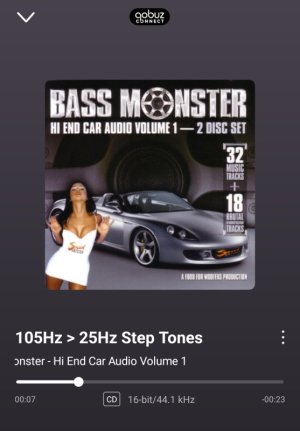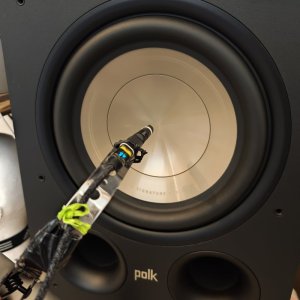As I no longer had plans to go out today, I decided to try out some music apps. I've just got a bit curious, you see.
Since I was at it, I also compared the casts from each company. It was my first time testing Qobuz Connect.
#Disclaimer#
I'm not a measurement specialist. I'm an amateur who occasionally plays around with microphones. I can't guarantee the reliability of the measurement results.
First, sound measurement.
I inserted the IMM-6C into the subwoofer port and compared the bass response.
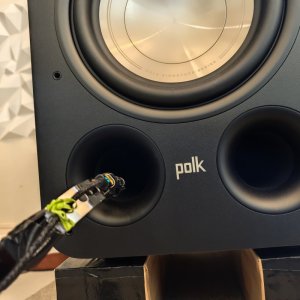
音源: 105hz-25hz Step tones
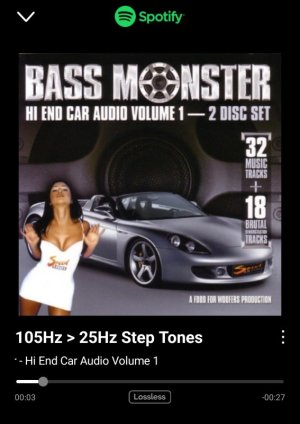

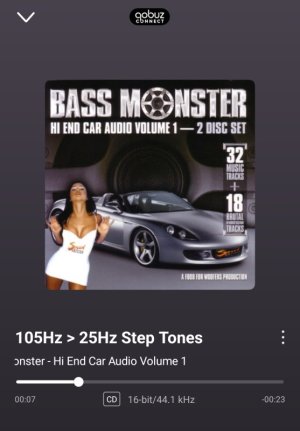
Spotify : 16bit/44.1kHz
Amazon : SD
Qobuz : 16bit/44.1kHz
(For some reason, it was in SD quality on Amazon. It used to be HD though...)
[Measurement results]
This is a overlaying responses from Qobuz and Spotify.

This is a overlaying responses from Amazon and Spotify.

I believe it is fair to say that the frequency responses of the three parties are entirely consistent. No differences can be discerned.
Next is 20hz-20kHz sweep. Set the microphone on the tweeter and try to measure the high frequencies mainly in the high frequencies.
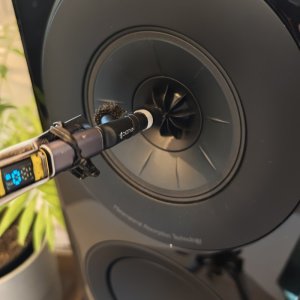
(I switched off the sub output on the Amp Ultra, switched to mono playback, and disconnected one of the speaker cables. This measurement is for a single speaker only.)

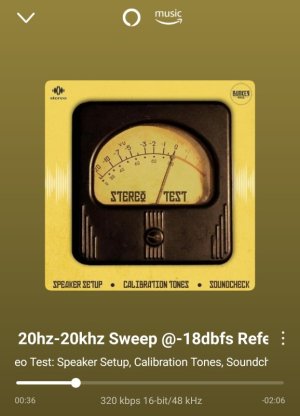
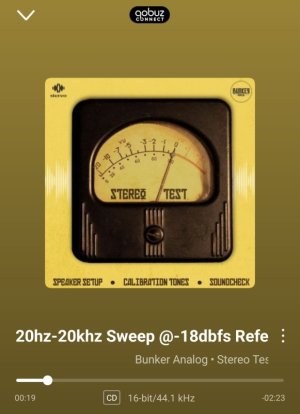
Spotify : 16/44.1
Amazon : SD
Qobuz : 16/44.1
[Results]
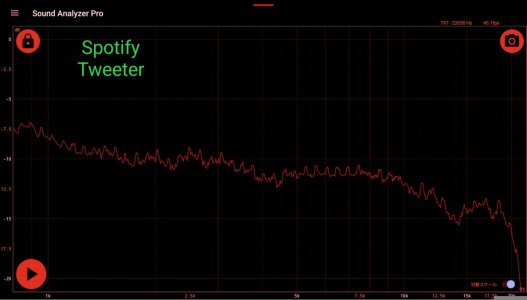
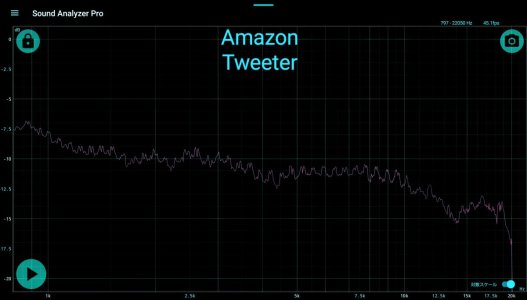

Spotify vs Qobuz
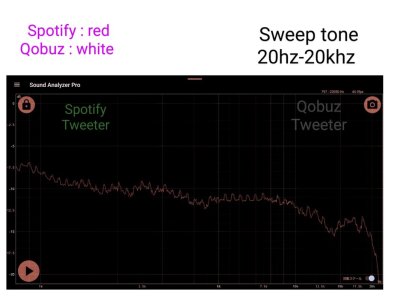
Spotify vs Amazon
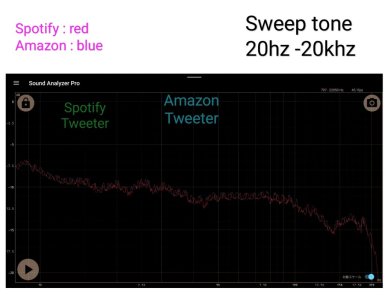
The responses from Spotify and Qobuz were almost identical. I believe this falls within the margin of error. Only Amazon provided a slightly different response.
Amazon only stocks SD versions, so I sought out an HD track to test. This one is a sign sweep.
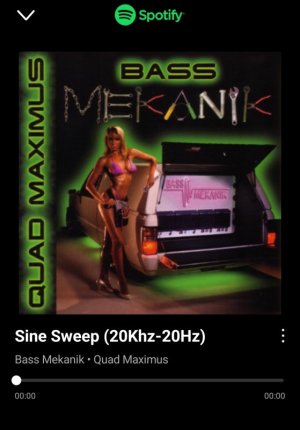
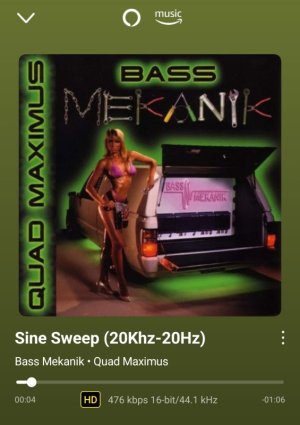

Spotify : 16/44.1
Amazon : 16/44.1
Qobuz : 16/44.1
[Results]

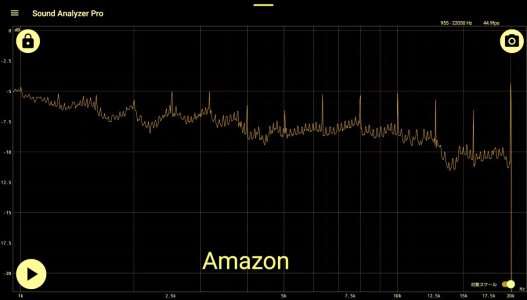
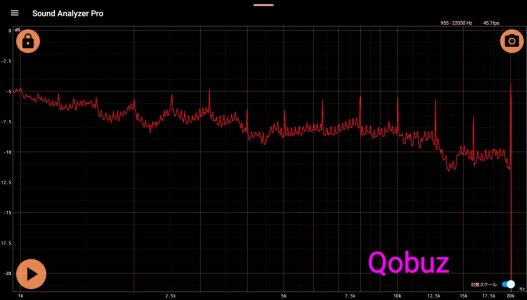
Spotify vs Amazon
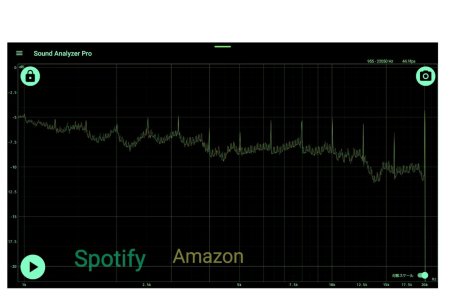
Spotify vs Qobuz
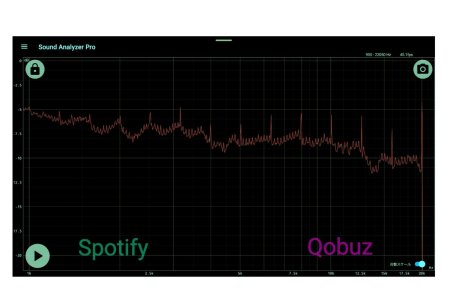
Amazon vs Qobuz
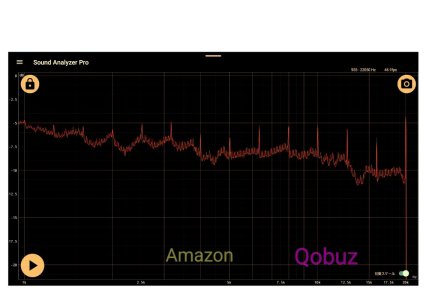
Here too, Spotify and Qobuz are almost same, but Amazon produced slightly different results. (But, the difference is very small. )
Next, I'll try it on a music track.
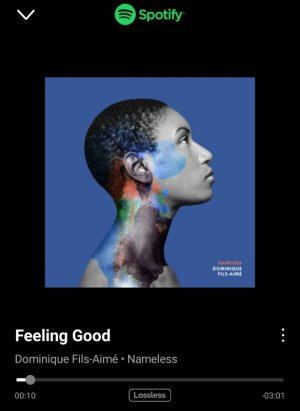


Spotify : 16/44.1
Amazon : 24/48
Qobuz : 24/88.2
[Results]
These are the measurement results obtained by playing only the first 10 seconds of the track.
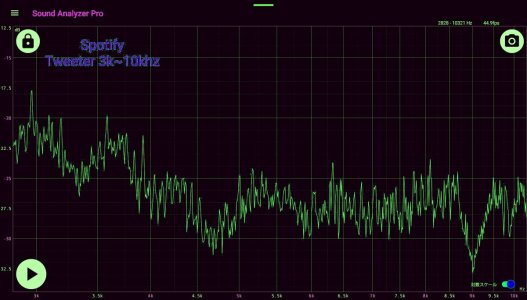
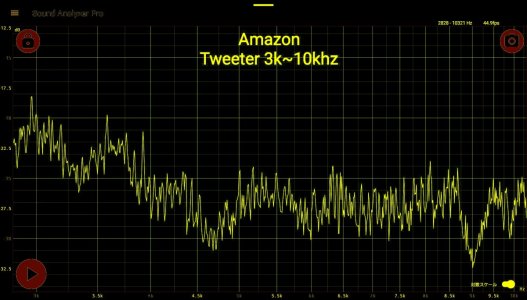
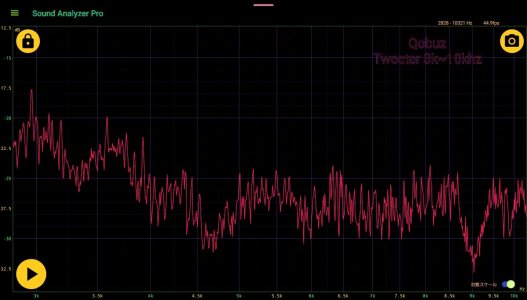
Spotify vs Amazon
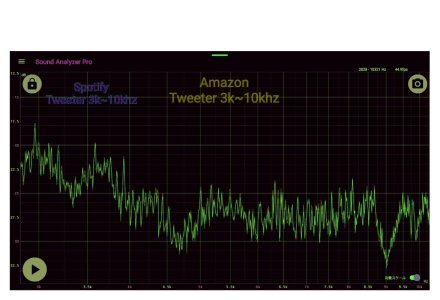
Spotify vs Qobuz

Amazon vs Qobuz
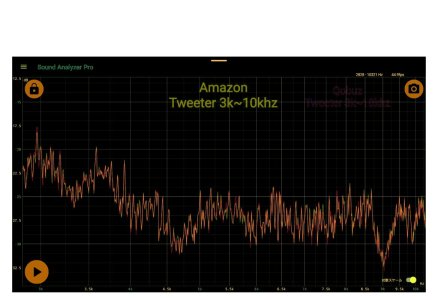
They were largely consistent. I think this is likely within the margin of measurement error. Even if it were not, I'm not sure whether I can hear the difference..
Up until now, I've been using the Android 'Sound Analyzer Pro' app, but I've decided to try another test using the 'Audio tool' app.
This track was played for one minute and captured using the Audio tool's spectrogram.



Spotify : 24/44.1
Amazon : 24/96
Qobuz : 24/96
[Results]
From top to bottom: Spotify, Amazon, Qobuz.
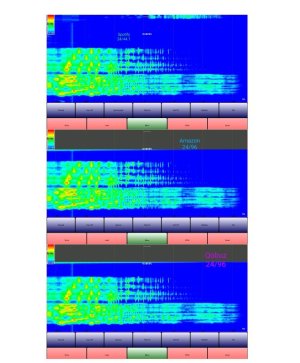
(A spectrogram is a graph representing three dimensions: time, frequency, and signal strength. By displaying time along the vertical axis, frequency along the horizontal axis, and signal strength through colour intensity or brightness, it enables visual analysis of how a signal changes over time.)
At first glance, no difference is apparent. To examine the high-frequency extension, let us zoom in.

None of the three showed any noticeable difference in high-frequency extension. If I were to point out a difference at all, I detected a slightly stronger signal in Qobuz between 12kHz and 18kHz. This is the section marked with the red square. As I only measured this once, I cannot say whether this is an error. I shall try testing it again when I have the time.
(Probably around the 0:50 mark of this track.)
One last thing.
I captured this song using "Chart" in the Audio tool app.
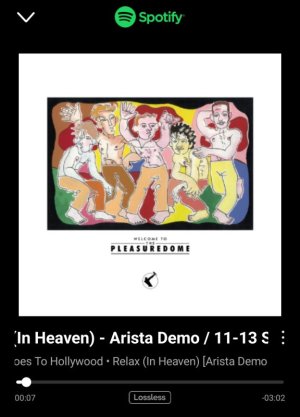

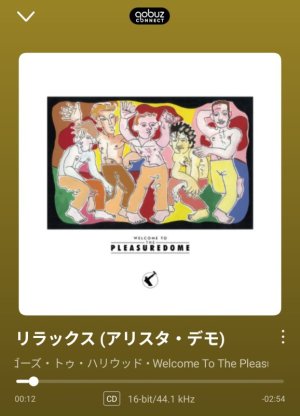
Spotify : 16/44.1
Amazon : 16/44.1
Qobuz : 16/44.1
[Results]
Spotify vs Amazon

Spotify vs Qobuz

Amazon vs Qobuz

This chart has time on the horizontal axis and volume on the vertical axis. It is the same as a stock price chart.
.......
I was feeling rather weary, so I decided to test the cast function while enjoying some music.
[Stress Test]
To compare Spotify Connect, AlexaCast, and Qobuz Connect, we conducted controller operation checks.
This shows the operation when connecting a phone to a Bluetooth speaker and controlling it via the Amazon app. It is very smooth with no delay.
View attachment aee25541-b87d-407e-b8ed-ef40c0880b0d-1_all_2452.mp4
Using this as a benchmark, we checked how each company's casting function operates.
Spotify Connect



View attachment 461.mp4
Spotify Connect is almost as comfortable as Bluetooth. I'd give it five stars, but since it became lossless compatible, it feels slightly less responsive, so four stars.
Amazon AlexaCast
View attachment aee25541-b87d-407e-b8ed-ef40c0880b0d-1_all_2438.mp4
As if the comfort of Bluetooth connectivity had been a lie, AlexaCast simply stops listening to me altogether. I knew this would happen, but it's still a terribly disappointing outcome as usual. Honestly, I don't want to give it a single star..
Qobuz Connect


View attachment aee25541-b87d-407e-b8ed-ef40c0880b0d-1_all_2437.mp4
Initially, it was very comfortable. I thought it was excellent movement for a newcomer. However, that was only at first..
When subjected to strong stress, the sound would cut out or start looping, eventually becoming silent. Finally, the connection was lost, and music began blaring loudly from the smartphone's speaker.
There may still be bugs remaining. If the operation stabilises, it could become quite good, so I'm giving it three stars with high hopes.
To be continued..
Since I was at it, I also compared the casts from each company. It was my first time testing Qobuz Connect.
#Disclaimer#
I'm not a measurement specialist. I'm an amateur who occasionally plays around with microphones. I can't guarantee the reliability of the measurement results.
First, sound measurement.
I inserted the IMM-6C into the subwoofer port and compared the bass response.

音源: 105hz-25hz Step tones



Spotify : 16bit/44.1kHz
Amazon : SD
Qobuz : 16bit/44.1kHz
(For some reason, it was in SD quality on Amazon. It used to be HD though...)
[Measurement results]
This is a overlaying responses from Qobuz and Spotify.

This is a overlaying responses from Amazon and Spotify.

I believe it is fair to say that the frequency responses of the three parties are entirely consistent. No differences can be discerned.
Next is 20hz-20kHz sweep. Set the microphone on the tweeter and try to measure the high frequencies mainly in the high frequencies.

(I switched off the sub output on the Amp Ultra, switched to mono playback, and disconnected one of the speaker cables. This measurement is for a single speaker only.)



Spotify : 16/44.1
Amazon : SD
Qobuz : 16/44.1
[Results]



Spotify vs Qobuz

Spotify vs Amazon

The responses from Spotify and Qobuz were almost identical. I believe this falls within the margin of error. Only Amazon provided a slightly different response.
Amazon only stocks SD versions, so I sought out an HD track to test. This one is a sign sweep.



Spotify : 16/44.1
Amazon : 16/44.1
Qobuz : 16/44.1
[Results]



Spotify vs Amazon

Spotify vs Qobuz

Amazon vs Qobuz

Here too, Spotify and Qobuz are almost same, but Amazon produced slightly different results. (But, the difference is very small. )
Next, I'll try it on a music track.



Spotify : 16/44.1
Amazon : 24/48
Qobuz : 24/88.2
[Results]
These are the measurement results obtained by playing only the first 10 seconds of the track.



Spotify vs Amazon

Spotify vs Qobuz

Amazon vs Qobuz

They were largely consistent. I think this is likely within the margin of measurement error. Even if it were not, I'm not sure whether I can hear the difference..
Up until now, I've been using the Android 'Sound Analyzer Pro' app, but I've decided to try another test using the 'Audio tool' app.
This track was played for one minute and captured using the Audio tool's spectrogram.



Spotify : 24/44.1
Amazon : 24/96
Qobuz : 24/96
[Results]
From top to bottom: Spotify, Amazon, Qobuz.

(A spectrogram is a graph representing three dimensions: time, frequency, and signal strength. By displaying time along the vertical axis, frequency along the horizontal axis, and signal strength through colour intensity or brightness, it enables visual analysis of how a signal changes over time.)
At first glance, no difference is apparent. To examine the high-frequency extension, let us zoom in.

None of the three showed any noticeable difference in high-frequency extension. If I were to point out a difference at all, I detected a slightly stronger signal in Qobuz between 12kHz and 18kHz. This is the section marked with the red square. As I only measured this once, I cannot say whether this is an error. I shall try testing it again when I have the time.
(Probably around the 0:50 mark of this track.)
One last thing.
I captured this song using "Chart" in the Audio tool app.



Spotify : 16/44.1
Amazon : 16/44.1
Qobuz : 16/44.1
[Results]
Spotify vs Amazon

Spotify vs Qobuz

Amazon vs Qobuz

This chart has time on the horizontal axis and volume on the vertical axis. It is the same as a stock price chart.
.......
I was feeling rather weary, so I decided to test the cast function while enjoying some music.
[Stress Test]
To compare Spotify Connect, AlexaCast, and Qobuz Connect, we conducted controller operation checks.
This shows the operation when connecting a phone to a Bluetooth speaker and controlling it via the Amazon app. It is very smooth with no delay.
View attachment aee25541-b87d-407e-b8ed-ef40c0880b0d-1_all_2452.mp4
Using this as a benchmark, we checked how each company's casting function operates.
Spotify Connect
View attachment 461.mp4
Spotify Connect is almost as comfortable as Bluetooth. I'd give it five stars, but since it became lossless compatible, it feels slightly less responsive, so four stars.
Amazon AlexaCast
View attachment aee25541-b87d-407e-b8ed-ef40c0880b0d-1_all_2438.mp4
As if the comfort of Bluetooth connectivity had been a lie, AlexaCast simply stops listening to me altogether. I knew this would happen, but it's still a terribly disappointing outcome as usual. Honestly, I don't want to give it a single star..
Qobuz Connect
View attachment aee25541-b87d-407e-b8ed-ef40c0880b0d-1_all_2437.mp4
Initially, it was very comfortable. I thought it was excellent movement for a newcomer. However, that was only at first..
When subjected to strong stress, the sound would cut out or start looping, eventually becoming silent. Finally, the connection was lost, and music began blaring loudly from the smartphone's speaker.
There may still be bugs remaining. If the operation stabilises, it could become quite good, so I'm giving it three stars with high hopes.
To be continued..
Attachments
Last edited:

